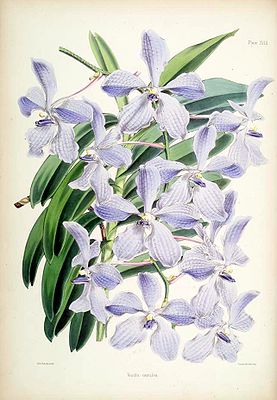Vanda coerulea
| Vanda coerulea | ||||||||||||
|---|---|---|---|---|---|---|---|---|---|---|---|---|

Vanda coerulea |
||||||||||||
| Systematics | ||||||||||||
|
||||||||||||
| Scientific name | ||||||||||||
| Vanda coerulea | ||||||||||||
| Handle. ex Lindl. |
The orchid Vanda coerulea is an epiphytic growing plant from Southeast Asia.
description
Vanda coerulea grows as a monopodial epiphyte . The shoot reaches a length of 5 to 23 cm, according to other information up to 80 or 150 cm, with a diameter of 0.8 to 1.5 cm. The two-line, thick leathery leaves are 7.5 to 26 cm long and 1.3 to 3 cm wide. The tip is asymmetrically bilobed.
From October to November, one to three inflorescences appear from each leaf axil. The inflorescence axis is 20 to 60 cm long, 6 to 15 flowers are in the slightly zigzag growing front half. The broad, oval bracts are about 1 cm in size. Pedicel and ovary are bluish white and measure 4.5 to 6 cm. The non-scented flowers are paper-like, thin, blue, they open wide, their diameter is 6 to 9 cm. The sepals are broadly inverted-egg-shaped, 3.5 to 5 cm long and 1.7 to 3.5 cm wide, abruptly narrowed (nailed) at the base for a short distance. The petals are similarly shaped and about the same size as the outer petals, the nail is slightly twisted. Sepals and petals are covered by darker leaf veins with a reticulate pattern. The lip is fleshy and has a slightly conical, blunt-ended spur at the base. The side lobes of the three-lobed lip stand upright and are white on the outside with yellow dots. The end of the middle lobe is cut off and slightly drawn in. There are three longitudinal keels on the lip. The column is 0.4 to 0.6 cm long with a white stamen .
The number of chromosomes is 2n = 38.
distribution
Vanda coerulea is native to Southeast Asia, its range extends over the northeast of India, the south of the Chinese province of Yunnan, Myanmar and the north of Thailand. It occurs at altitudes from 800 to 1300, more rarely up to 1700 meters. It grows as an epiphyte in light treetops in open forests and on trees along rivers.
Systematics and botanical history
Vanda coerulea was found in India by William Griffith in 1837 and described by John Lindley in 1850 using a herbal specimen . In the same year, the plant collector Thomas Lobb sent live plants to the English nursery Veitch and Sons .
use
This orchid became a popular ornamental plant because of its large flowers, which are colored with the rare color blue. The massive collection of wild plants meant that Vanda coerulea was temporarily listed in Appendix I of the Washington Convention on Endangered Species . Important was Vanda coerulea also in breeding, it is a parent of the "classic" hybrids Vanda Rothschildiana and was introduced primarily because of their color in numerous other intersections.
In cultivation, Vanda coerulea requires a bright location. During the dry rest period, the temperature can drop to 12 ° C.
supporting documents
- ↑ a b c d Alexandra Bell, Xinqi Chen: Vanda . In: Wu Zhengyi, Peter H. Raven (Ed.): Flora of China . tape 25 . Missouri Botanical Garden Press, St. Louis 2009, pp. 472 ( efloras.org ).
- ^ A b F. G. Brieger, R. Maatsch, K. Senghas (eds.): Rudolf Schlechter: Die Orchideen . 3. Edition. Volume I / B. Paul Parey, 1992, ISBN 3-489-78622-X , p. 1217 .
- ↑ a b c d e H. Bechtel, Ph. Cribb, E. Launert: Orchideenatlas . 3. Edition. Ulmer, Stuttgart 1993, ISBN 3-8001-6199-0 , p. 448-449 .
- ↑ Jürgen Röth: Orchids . VEB Deutscher Landwirtschaftsverlag, Berlin 1983, p. 319 .
